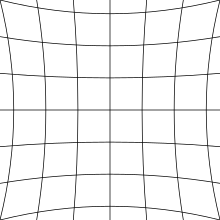
Back Perspectiva curvilínea Spanish Perspective curviligne French Perspektywa krzywoliniowa Polish Perspectiva curvilínea Portuguese


Curvilinear perspective, also five-point perspective, is a graphical projection used to draw 3D objects on 2D surfaces. It was formally codified in 1968 by the artists and art historians André Barre and Albert Flocon in the book La Perspective curviligne,[1] which was translated into English in 1987 as Curvilinear Perspective: From Visual Space to the Constructed Image and published by the University of California Press.[2]
Curvilinear perspective is sometimes colloquially called fisheye perspective, by analogy to a fisheye lens. In computer animation and motion graphics, it may also be called tiny planet.
- ^ Albert Flocon and André Barre, La Perspective curviligne, Flammarion, Éditeur, Paris, 1968
- ^ Albert Flocon and André Barre, Curvilinear Perspective: From Visual Space to the Constructed Image, (Robert Hansen, translator), University of California Press, Berkeley and Los Angeles, California, 1987 ISBN 0-520-05979-4
© MMXXIII Rich X Search. We shall prevail. All rights reserved. Rich X Search